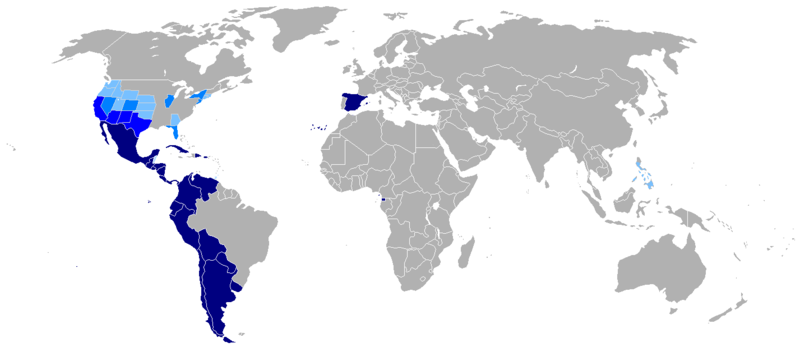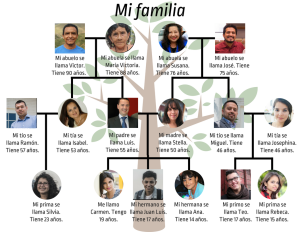La ascendencia de los latinos en Estados Unidos
58 millones o 18% de estadounidenses eran latinos en 2016. Era el mayor grupo étnico después del grupo racial “blanco, no hispano”. De la población latina en Estados Unidos en 2015, la mayoría (65,6%) no nació en el extranjero. Es decir, solo el 34,4% de los latinos en Estados Unidos son inmigrantes (Pew Research Center).
En una misma familia es posible tener parientes nativos de Estados Unidos y también parientes inmigrantes. Varios grupos latinos mantienen nexos transnacionales con el país de sus antepasados porque hay comunicación con su familia en el extranjero. Con estas conexiones, crean comunidades en lugares que están lejos del país de origen. Por ejemplo, hay una notable comunidad transnacional mexicana con un nexo entre Michoacán, México, y Anchorage, Alaska (Komarnisky).
La ascendencia en porcentajes México en el año 1830
Comprensión
Verdadero o falso
Decide si la oración es verdadera o falsa. Corrige las oraciones falsas.
- En 2016, veinte por ciento de la población estadounidense era latino.
- La mayoría de los latinos nacieron en el extranjero.
- En una familia, es posible tener un hermano inmigrante y un hermano nativo estadounidense.
- Una familia transnacional no tiene conexiones con el país de origen.
- Hay comunidades transnacionales que son geográficamente muy lejos.
¿Cómo se explica?
- ¿Qué porcentaje de latinos estadounidenses tiene ascendencia mexicana?
- Based on the map on the right of Mexican territory in 1830, what is one way to explain why Mexican-Americans make up the largest group? Use the vocabulary above to help you explain. It is okay to use “Spanglish” since we have not learned enough words yet for you to answer in a full sentence in Spanish.
- El segundo grupo es puertorriqueño. Puerto Rico no es un país independiente. Es un estado libre asociado, parte de Estados Unidos. What is one way to explain why Puerto Ricans make up the second largest group? You can explain your answer in “Spanglish” using the vocabulary from above.
Conexiones
Using the information you learned in this lesson, choose the right sentence beginnings and endings to create statements that are true for you.
| A diferencia de (unlike) / Como (like) |
inmigrante / nativo/a. |
|
| la mayoría de los latinos en Estados Unidos, yo soy …. | ||
| la mayoría los latinos en Estados Unidos, mi mamá (or papá—your choice) es … |
Los latinos en algunas ciudades estadounidenses
- Los Ángeles, California 49%
- Pomona, California 70,5%
- Aurora, Illinois 42,7%
- Chicago, Illinois 28%
- Hialeah, Florida 96,3%
- Miami, Florida 73,6%
- Reading, Pensilvania 63,1%
- Filadelfia, Pensilvania 14,4%
- El Paso, TX 80,7%
- Austin, TX 34,8%
Datos demográficos
Practice giving percentages with a partner by asking about the percentage of Latinos in several cities from the list above. Write out the numbers in your notebook to practice spelling.
Modelo:
Estudiante 1: ¿Cuál es el porcentaje de latinos en Los Ángeles?
Estudiante 2: Es cuarenta y nueve por ciento.
A pensar
Notice that the demographics from one city to another in the same state vary substantially. What observations or even theories can you make about the demographic differences? Discuss your ideas with your group.
Deportistas latinos
In this section, we will talk a bit about playing sports. Can you name a U.S. Latino athlete? What sport does he or she play?

| Jugar = To play | |
|---|---|
| yo juego | nosotros jugamos |
| tú juegas | vosotros jugáis |
| él juega | ellos juegan |
| Hacer = To make or to do | |
|---|---|
| yo hago | nosotros hacemos |
| tú haces | vosotros hacéis |
| él hace | ellos hacen |
Hablando de deportes: jugar y hacer
Take a moment to copy these new two verbs in your notebook. Then, complete the activity below.
¿A qué deporte juegas/juega/juegan … ?
In pairs, ask one another about the sports each athlete plays. Take turns asking and answering. Notice that you will be using different verb forms to ask and answer the question.
Modelo: Somos Horford y Rebecca Lobo • baloncesto
Estudiante 1: ¿A qué deporte juegan ustedes?
Estudiante 2: Jugamos al baloncesto.
- Son Danell Leyva y Laurie Hernández • gimnasia artística
- Soy Sarah Robles • levantamiento de pesas
- Es Andrés Galarraga • béisbol
- Soy Carmelo Anthony • baloncesto
- Somos Antonio Vargas y Óscar de la Hoya • boxeo
- Son Leonel Manzano y Brenda Martínez • atletismo
Ask your partner this question: ¿A qué deporte juegas tú?
As homework, redo this activity. Write down the questions and their answers in your notebook.
¿Qué significa “Latino”?
People from Latin American countries generally refer to themselves by their nationalities to indicate their country of origin. For example, a woman from Venezuela will simply call herself “venezolana”, no matter where her ancestors came from. They don’t often use Latino, Hispanic, or hyphenated forms such as “italo-argentinos”. When people from Latin America move to the United States, they are often identified as Latino, Latinx, or Hispanic.
What does Latino mean in the context of the United States? Compare the uses of the words “Latino/a”, “Latinx”, and “Hispanic” by scanning the USA Today article, “‘Latinx’ explained: A History of the Controversial Word and How to Pronounce It.”
After completing this theme, I can …
- in Spanish, state the number and percentage of the Latino population in United States
- in Spanish, give a definition for a transnational family.
- in English, explain why Mexican-Americans and Puerto Ricans make up the largest Latino groups in the U.S.
- in Spanish, use numbers 0 – 100 and por ciento to express percentages.
- in Spanish, talk about the sports people play using hacer and jugar.


